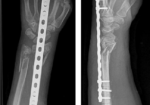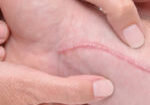Cyclist Injuries: Avoiding Hand Injuries and Treatment Strategies
Filed under Treatments
RAPID REVIEW
Chiaramonte, R., Pavone, P., Musumeci, G., Di Rosa, M., & Vecchio, M. (2022). Preventive strategies, exercises, and rehabilitation of hand neuropathy in cyclists: A systematic review. Journal of Hand Therapy, 35, 164-173.

The Skinny:
The study was a systematic review done to get clarification on the diagnostic process for cyclist injury specifically for hand neuropathies and strategies for prevention and treatment.
In the Weeds: Literature was searched in the following databases PubMed, EMBASE, the Cochran Library, and Web of Science.
Exclusion criteria excluded duplicate studies, injuries that were related to sports not specific to cycling, and articles that were not related to peripheral nerve injuries.
Inclusion criteria: Articles met the inclusion criteria if they included hand palsy due to peripheral nerve compressions of the ulnar and or median nerve specific to the cyclist injury.
Initially, the search yielded 15,371 articles, after screening for inclusion-exclusion a total of 48 full-text articles were read, and finally 20 publications that met the full criteria. Two separate reviewers independently reviewed identified articles.
Bringing it Home:

From the literature review, they concluded the following prevention and therapeutic strategies for treating common cyclist injuries.
1.) Educate cyclists on frequent changes in the position of the upper limb, neck, and shoulder
girdle (Anderson and Bovim, 1997)
2.) Adapt the handlebars or change position and change riding position (Haloua, et al,
1987)
3.) Minimize nerve compressions by avoiding prolonged elbow extension and
flexion, and wear neutral wrist orthosis and elbow orthosis at night. Use padded gloves (Dy
and Mackinnon, 2016)
4.) No treatment (Haloua et al, 1987, North et al, 1980 and Selcuk et al, 2015)
5.) Rest from the activity causing the compression (Malmaris and Zadeh, 1990)
6.) Cryotherapy, exercise, and electrical stimulation (Bransdma, 1995)
7.) Anti-inflammatory drugs and steroid injections (Ummer and Albohm, 1990).
There are a few treatments available for peripheral nerve injuries caused by cycling, however, there is no specific protocol for these injuries according to this systematic review.
Rating:
3/5
There is very limited evidence on treatment options for compression neuropathies caused by cycling. However, there have been a large number of studies looking at conservative treatment for peripheral neuropathies they are just not specific to one sport. The best course of treatment for cyclists is not clearly defined and this may require therapists to rely on their current clinical skills and other research.
References
Andersen, K. V., & Bovim, G. (1997). Impotence and nerve entrapment in long-distance amateur cyclists. Acta neurologica Scandinavica, 95(4), 233–240. https://doi.org/10.1111/j.1600-0404.1997.tb00104.x
Brandsma, J. W. (1995). Manual muscle strength testing and dynamometry for bilateral ulnar neuropraxia in a surgeon. Journal of Hand Therapy, 8(3), 191-194.
Dy, C. J., & Mackinnon, S. E. (2016). Ulnar neuropathy: evaluation and management. Current rev musculoskeletal med, 9, 178-184.
Haloua, J. P., Collin, J. P., & Coudeyre, L. (1987). Paralysis of the ulnar nerve in cyclists. Annales de Chirurgie de la Main: Organe Officiel des Societes de Chirurgie de la Main, 6(4), 282-287.
Kalainov, David & Hartigan, Brian. (2003). Bicycling-induced ulnar tunnel syndrome. American journal of orthopedics (Belle Mead, N.J.). 32. 210-1.
Maimaris, C., & Zadeh, H. G. (1990). Ulnar nerve compression in the cyclist’s hand: two case reports and review of the literature. British journal of sports medicine, 24(4), 245.
Noth, J., Dietz, V., & Mauritz, K. H. (1980). Cyclist’s palsy: Neurological and EMG study in 4 cases with distal ulnar lesions. Journal of the neurological sciences, 47(1), 111-116.
Ummer, C., & Albohm, M. (1997). Cyclist palsy in the 90s. Human kinetics. 20-21.
Selçuk, B., Kurtaran, A., Yildirim, Ö., Değirmenci, İ., & Akyüz, M. (2015). Cyclist’s Neuropathy: A Compression Syndrome of the Deep Motor Branch of the Ulnar Nerve: A Case Report. Neurosurgery Quarterly, 25(3), 337-340.
1 Comment
Leave a Comment
More To Read
Outcomes of Dorsal Bridging Plates
Outcomes of Dorsal Bridging Plates Fares, A. B., Childs, B. R., Polmear, M. M., Clark, D. M., Nesti, L. J., & Dunn, J. C. (2021). Dorsal Bridge Plate for Distal Radius Fractures: A Systematic Review. The Journal of Hand Surgery. https://doi-org.methodistlibrary.idm.oclc.org/10.1016/j.jhsa.2020.11.026 The Skinny Distal radius fractures (DRF) are a common injury that we see in…
Read MoreHand Therapy Interventions for Distal Upper Extremity Injuries and Conditions
Takata, S.C., Wade, E.T., & Roll, S.C. (2019). Hand therapy interventions, outcomes, and diagnoses evaluated over the last 10 years: A mapping review linking research to practice. Journal of Hand Therapy, 32(1), 1–9. Written by Brittany Carrie The Skinny Approximately 26.9% of orthopedic injuries and disorders of the upper extremity occur worldwide. Injuries are most…
Read MoreWays to Improve HEP Compliance in Hand Therapy
Ways to Improve HEP Compliance in Hand Therapy By: Dalton Busch One of the most important ways we see our patient’s progress is by assuring they are compliant with their prescribed home exercise program (HEP). Our patients are always encouraged to adhere to their prescribed program but compliance is easier said than done. Reminding patients…
Read MoreScar Management in Hand Therapy
Hand therapists may feel they are in a constant battle with scar tissue. It can limit ROM, cause pain, impede other structures, and leave a less than desirable appearance. Scar tissue starts forming as early as 2 weeks after an injury and can continue forming for up to 2 years. The earlier action is taken…
Read MoreSign-up to Get Updates Straight to Your Inbox!
Sign up with us and we will send you regular blog posts on everything hand therapy, notices every time we upload new videos and tutorials, along with handout, protocols, and other useful information.







As a triathlete and a CHT this has burdened me for quite some time.
I struggle to find a balance between a comfortable grip on my handlebars and preventing hand numbness.